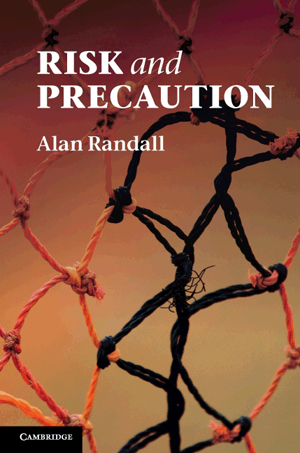Home > Press > The risky business of innovation: a new framework for risk management
 |
| In his new book, Professor Alan Randall argues the challenge is to avoid unnecessary risk in technological advances but still be able to reap their benefits. |
Abstract:
Traditional techniques of risk management are unable to keep up with technological advancements, leaving some potentially dangerous innovations unregulated while over-regulating some that are relatively benign, according to a new book by the University of Sydney's Professor Alan Randall.
The risky business of innovation: a new framework for risk management
Sydney, Australia | Posted on March 2nd, 2011Climate change, genetic modification, synthetic organic compounds, nuclear technologies and nanotechnology are all areas in which risk management may be failing us, Professor Randall says.
"In some of these cases too much is being done, in others too little, and in most of them the wrong things are being done. We are learning that natural systems are much more complex than previously understood," he says.
He believes that traditional approaches fail to prevent potential dangers because they do not do enough to prevent threat and are too slow in diagnosing it, and are only applied after the problem is entrenched in the economy and our way of life.
"There is a growing sense among the public that technology is developing the capacity for damage on a scale so vast that it is, for that reason alone, threatening. Innovations readily become entrenched in the economy and environment, and some of them turn bad. Playing catch-up is so much harder than getting it right at the beginning.
"We sense a broad public impatience with the 'charge ahead and, if necessary, clean up the mess later' approach to risk management," Professor Randall says.
The difficulty of proving cause and effect is a major issue in mitigating risk, as it simply cannot keep up with rapid advancements in technology. A Dutch study revealed that if measures had been taken in the 1960s when it was established that asbestos could cause mesothelioma, but not yet proven, 34,000 lives could have been saved in the Netherlands alone. Although the health risk was suspected as early as 1906, asbestos was not banned in Europe until 1998.
Despite research suggesting nanoparticles can be exceptionally dangerous, nanotechnology has advanced faster than the capacity of regulators to assess its social and environmental impacts. As a result, the industry remains largely unregulated.
"The potential threats from nanotechnology are receiving increasing recognition, and there are calls for more active research with a view to systematic screening, testing and surveillance. But there is also a burgeoning industry anxious to avoid what it is likely to see as over-regulation."
The challenge, according to Professor Randall, is to avoid unnecessary risk in technological advances but still be able to reap their benefits. He proposes a framework for risk management that reduces the threat of harm without losing out on the potential profits of innovation.
"The fundamental framework I am proposing would combine elements of traditional risk management with a more precautionary approach, screening more innovations for risk, identifying real threats sooner, and allowing less-risky innovations to proceed. If we can quickly identify those cases where further testing is necessary, precaution could be less intrusive and costly while still providing substantial protection from harm."
Professor Randall, a Professor of Agricultural and Resource Economics, recently joined the Faculty of Agriculture, Food and Natural Resources from his previous appointment at the Ohio State University. His new book, Risk and Precaution, has been released this month.
####
For more information, please click here
Contacts:
Katie Szittner
9351 2261
Copyright © University of Sydney
If you have a comment, please Contact us.Issuers of news releases, not 7th Wave, Inc. or Nanotechnology Now, are solely responsible for the accuracy of the content.
| Related News Press |
News and information
![]() Researchers develop molecular qubits that communicate at telecom frequencies October 3rd, 2025
Researchers develop molecular qubits that communicate at telecom frequencies October 3rd, 2025
![]() Next-generation quantum communication October 3rd, 2025
Next-generation quantum communication October 3rd, 2025
![]() "Nanoreactor" cage uses visible light for catalytic and ultra-selective cross-cycloadditions October 3rd, 2025
"Nanoreactor" cage uses visible light for catalytic and ultra-selective cross-cycloadditions October 3rd, 2025
Announcements
![]() Rice membrane extracts lithium from brines with greater speed, less waste October 3rd, 2025
Rice membrane extracts lithium from brines with greater speed, less waste October 3rd, 2025
![]() Researchers develop molecular qubits that communicate at telecom frequencies October 3rd, 2025
Researchers develop molecular qubits that communicate at telecom frequencies October 3rd, 2025
![]() Next-generation quantum communication October 3rd, 2025
Next-generation quantum communication October 3rd, 2025
![]() "Nanoreactor" cage uses visible light for catalytic and ultra-selective cross-cycloadditions October 3rd, 2025
"Nanoreactor" cage uses visible light for catalytic and ultra-selective cross-cycloadditions October 3rd, 2025
Interviews/Book Reviews/Essays/Reports/Podcasts/Journals/White papers/Posters
![]() Spinel-type sulfide semiconductors to operate the next-generation LEDs and solar cells For solar-cell absorbers and green-LED source October 3rd, 2025
Spinel-type sulfide semiconductors to operate the next-generation LEDs and solar cells For solar-cell absorbers and green-LED source October 3rd, 2025
![]() Rice membrane extracts lithium from brines with greater speed, less waste October 3rd, 2025
Rice membrane extracts lithium from brines with greater speed, less waste October 3rd, 2025
Safety-Nanoparticles/Risk management
![]() Onion-like nanoparticles found in aircraft exhaust May 14th, 2025
Onion-like nanoparticles found in aircraft exhaust May 14th, 2025
![]() Closing the gaps — MXene-coating filters can enhance performance and reusability February 28th, 2025
Closing the gaps — MXene-coating filters can enhance performance and reusability February 28th, 2025
|
|
||
|
|
||
| The latest news from around the world, FREE | ||
|
|
||
|
|
||
| Premium Products | ||
|
|
||
|
Only the news you want to read!
Learn More |
||
|
|
||
|
Full-service, expert consulting
Learn More |
||
|
|
||








